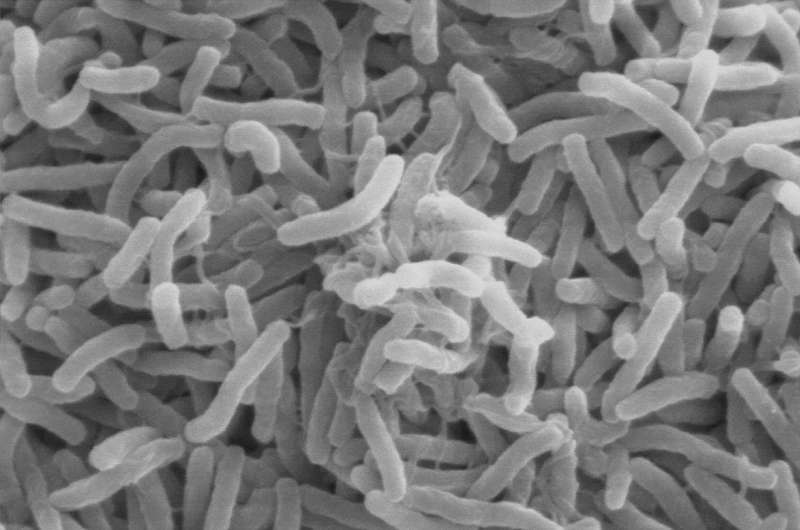April 25, 2016 report
Study reveals how cholera's two chromosomes communicate to coordinate replication

(Phys.org)—A team of researchers from France and Denmark, working at Institut Pasteur, in Paris has found the mechanism that is involved that allows dual chromosomes in Vibrio cholerae cells to split at the same time as part of replication. In their paper published in the journal Science Advances, the team describes how they closely studied cell replication in V. cholerae, the bacteria that cause cholera, and then verified their understanding of how chromosome division was occurring by disabling different parts involved in the process.
V. cholera has been studied extensively for some time as part of an ongoing process to either eliminate it as a threat to people, or to treat infections. As part of that effort, scientists have found that each bacterium has two chromosomes, both of which need to split prior to the cell splitting as part of its life cycle. Prior research has shown that the chromosomes split at the same time, which has suggested a means of communications between the two. In this new effort, the researchers have identified that means of communication and the parts of the chromosomes that are involved in the process.
The two chromosomes in each cell are called chr1 and chr2. Chr1 is a lot longer than chr2 and is the chromosome that initiates the entire division process, the team found, when a DnaA molecule binds to a part of the chromosome called ori2 leading to the replication process in chr1, along a circular path. When that path crosses a point the researchers have called crtS, a molecule called RctB is activated which makes its way to chr2 causing it to begins its replication process. The two processes then finish at very nearly the same time—just prior to the complete cell dividing—due to the physical proximity of the two chromosomes and the location of the crtS on chr1.
The team then deleted the crtS region in some of the bacteria and found that doing so caused problems with growth and DNA damage. They also allowed one group of the mutant bacteria to multiply over 200 generations to learn more about how the bacteria might compensate for the loss of crtS and discovered that that the mutations led only to mutations in RctB, which the team claims, shows that activation by RctB is a crucial part of the process.
More information: M.-E. Val et al. A checkpoint control orchestrates the replication of the two chromosomes of Vibrio cholerae, Science Advances (2016). DOI: 10.1126/sciadv.1501914
Abstract
Bacteria with multiple chromosomes represent up to 10% of all bacterial species. Unlike eukaryotes, these bacteria use chromosome-specific initiators for their replication. In all cases investigated, the machineries for secondary chromosome replication initiation are of plasmid origin. One of the important differences between plasmids and chromosomes is that the latter replicate during a defined period of the cell cycle, ensuring a single round of replication per cell. Vibrio cholerae carries two circular chromosomes, Chr1 and Chr2, which are replicated in a well-orchestrated manner with the cell cycle and coordinated in such a way that replication termination occurs at the same time. However, the mechanism coordinating this synchrony remains speculative. We investigated this mechanism and revealed that initiation of Chr2 replication is triggered by the replication of a 150-bp locus positioned on Chr1, called crtS. This crtS replication–mediated Chr2 replication initiation mechanism explains how the two chromosomes communicate to coordinate their replication. Our study reveals a new checkpoint control mechanism in bacteria, and highlights possible functional interactions mediated by contacts between two chromosomes, an unprecedented observation in bacteria.
Journal information: Science Advances
© 2016 Phys.org



















